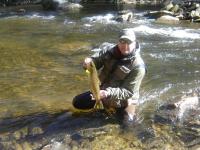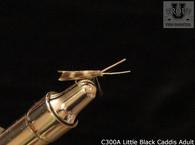Selecting Flies and the
Tools of Fly-fishing is
a Fly Fishing Basic
$29.95 Free Shipping
Fly fishing basics of choosing the right fly, fly line, fly rod, fly reel, leader, tippet, etc. for your particular needs and requirements is a step in the right direction towards success on any fly-fishing excursion.



The purpose, function and features of each fly-fishing tool, fly rod, fly reel, fly
line, flies, waders, etc. , including its construction and material, are thoroughly covered.



Example Script Segment on Tippets:
The following are some fly fishing basics that you should know if you are going to consistantly catch trout. Smaller size leaders are designated by their length and the tippet size number, which is designated by a “X” that identify the size and breaking strength of the tippet. The larger the number immediately preceded by “X” the smaller the diameter and lower the breaking strength of the tippet.
Larger size leaders do not use the “X” system to designate size. They are identified as being extra light, light, medium, heavy or extra heavy and may also be designated by the diameter of the tippet. If the tippet size is larger than the zero ”X” size designation, they are referred to by length and tippet size designated as the tested breaking strength. For instance, a designation of a tippet may be, a nine, foot leader with a .015-inch diameter tippet, or nine-foot leader with a breaking strength of ten pounds.
The larger the tippet, the more difficult it is to make the fly look and act natural. So from the
standpoint of the presentation the tippet should be as small in diameter as possible. However, since the tippet is also the weakest link between the angler and the fish a balance of choices must be made between the quality of presentation of the fly and the risk of a fish breaking the tippet.
The larger the fly, the larger the size tippet you can use without it adversely affecting the presentation of the fly. For example, this larger size streamer fly can be effectively presented on a much larger size tippet than this very small dry fly. Ideally, you would use a very small, light tippet for the dry fly – as small as possible without it compromising your ability to successfully fight and land the fish. Most anglers would much rather take their chances fighting a fish on light tackle than to fish heavier tackle.





